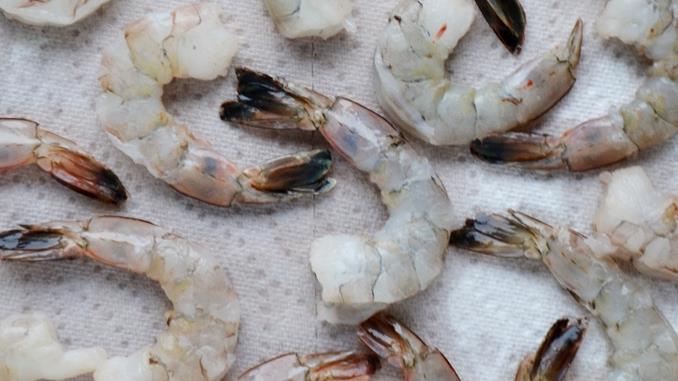We’ve all been there – you open up your freezer to find a bag of shrimp you forgot about, only to discover it has freezer burn Those white spots and icy coating don’t exactly look appetizing. But before you toss the shrimp in the trash, find out if it’s still safe to eat.
What Causes Freezer Burn on Shrimp?
Freezer burn occurs when air reaches the surface of the shrimp in the freezer. The moisture in the shrimp evaporates due to the dry air, leaving behind characteristic white spots or frosty coating.
Several factors can lead to freezer burn on shrimp:
- Improper storage – Loose packaging or seal allows air to reach the shrimp
- Temperature fluctuations – Inconsistent freezer temperature speeds up evaporation
- Long term storage – Freezer burn happens over time, so longer storage means higher risk
While unsightly, freezer burn itself doesn’t make the shrimp unsafe. It simply dries out the surface, changing the texture and taste. As long as the shrimp was stored properly at freezing temperatures, bacteria won’t grow.
Is it Safe to Eat Freezer Burned Shrimp?
The good news is that freezer burned shrimp is 100% safe to eat. The freezing process stops any bacterial growth, so freezer burn doesn’t introduce any biological hazards.
However, the quality of the shrimp will be lower from both a taste and texture standpoint. Here’s what to expect:
- Dry, tough texture – Loss of moisture leads to less tender shrimp
- Muted taste – Freezer burned areas lose flavor
- Unpleasant flavors – Freezer burn can create “off” tastes
While not dangerous, the decline in eating quality means freezer burned shrimp won’t be quite as enjoyable. It’s up to you whether it’s worth using.
Tips for Using Freezer Burned Shrimp
If your shrimp has a minor case of freezer burn, don’t toss it out just yet. There are ways to redeem mildly affected shrimp:
- Cut off any severely burned sections
- Brine in saltwater to rehydrate
- Marinate to impart flavor
- Cook in strongly flavored dishes like gumbo or curry
- Wrap in bacon or deep fry to mask texture issues
With the right techniques, you can breathe new life into shrimp suffering a touch of freezer burn. But if the burn is extensive, your best bet may be to cut your losses and say goodbye.
Preventing Freezer Burn on Shrimp
Stop freezer burn in its tracks with proper storage methods:
- Use airtight freezer bags or containers
- Exclude excess air when packaging
- Seal bags tightly
- Maintain a stable freezer temperature
- Avoid overloading freezer to allow air flow
- Store shrimp flat in a single layer
- Place towards back of freezer where temperature is most constant
With diligent freezer habits, you can avoid the dreaded shrimp freezer burn. Your tastebuds will thank you.
What to Look Out For
When inspecting your shrimp, watch for signs they may be unsafe to eat:
✔️ Dry, shriveled texture
✔️ Strong “fishy” smell
✔️ Unnatural colors like green, blue, or black
✔️ Slimy film on surface
✔️ Mold growth
These could indicate spoiled shrimp past the point of salvaging. Always discard shrimp with an off appearance or odor.
Final Tips for Freezer Burned Shrimp
Freezer burn may downgrade the quality, but doesn’t have to be a total loss. Keep these last tips in mind:
- Focus on flavor – Use bold spices, marinades and sauces
- Cook thoroughly – High heat helps firm up texture
- Cut slits for marinades – Allows flavor to penetrate
- Don’t overcook – Freezer burn makes shrimp dry out quicker
- Remove blackened sections – Trim off any inedible parts
- When in doubt, throw it out – Don’t risk getting sick
With a few easy practices, you can rescue freezer burned shrimp to be safe, appetizing, and delicious. Now you know you don’t have to say goodbye to shrimp with a case of freezer discoloration.

What is Freezer Burn and is it Safe to Eat?
Is it safe to eat freezer-burned shrimp?
Freezer-burned shrimp can be eaten without any fear of food poisoning. To make it palatable, it is recommended to incorporate it in a dish, preferably a stew, to re-hydrate the shrimp. Use herbs and spices to mask the freezer burn taste. However, if the shrimps are entirely discolored or have a strong ammonia smell, it is best to discard them.
Is it safe to eat frozen shrimp?
The shrimp should still be safe to cook and eat, you just might notice that it is dry or slightly tough rather than juicy. The texture is the most likely thing to be affected but you can often work around that. You can’t always avoid freezer burn, despite your best efforts. If your shrimp has noticeable freezer burn, don’t lose hope.
What happens if you freeze burnt shrimp?
Freezer burn happens when the moisture in the shrimp evaporates, leaving the shrimp dry and shriveled. This happens when the shrimp is exposed to air in the freezer without proper packaging. Freezer burnt shrimp does not affect the safety of the shrimp, but it does affect the quality and taste.
Can You reverse Freezer Burn on shrimp?
While you can’t completely reverse freezer burn on shrimp, you can still use them in cooking. Freezer burn leads to dehydration and affects taste and texture, but the shrimp usually remain safe to eat.
